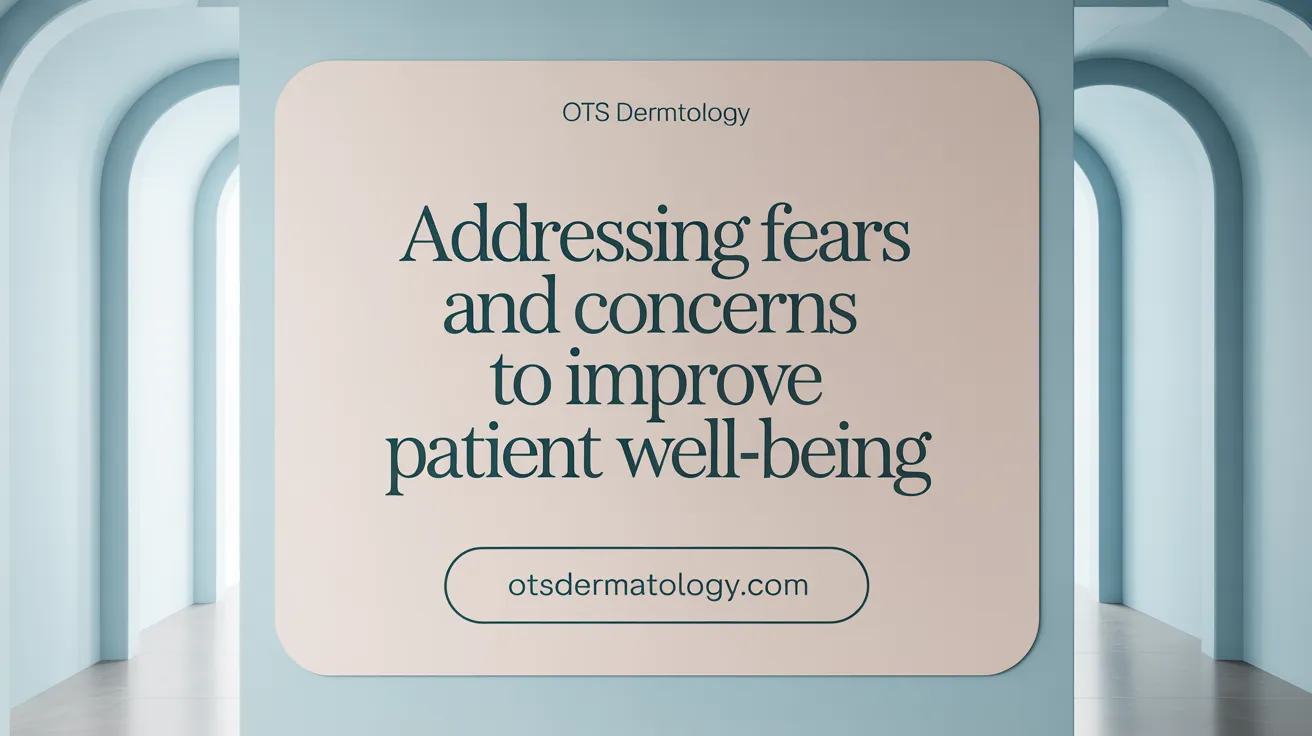Understanding the Crucial Role of Patient Experience in Dermatology Clinics
Importance of Patient Experience
Patient experience plays a pivotal role in dermatology care, influencing treatment adherence and overall health outcomes. Patients enter dermatology clinics with varying levels of knowledge about their skin conditions. Some may understand their diagnosis well, while others have limited awareness or harbor fears related to deterioration, infection, or scarring. Recognizing these concerns helps dermatologists tailor communication and care.
Overview of Dermatology Clinic Care
Effective communication is essential during dermatology consultations. Preparing with tools like preconsultation questionnaires can reveal patients' fears and expectations, often overlooked due to busy schedules. This patient-centered approach encourages shared decision-making, promotes informed consent, and fosters collaboration in treatment planning.
Connection Between Patient Experience and Clinical Outcomes
Addressing patients' insights, fears, and expectations improves psychological well-being and satisfaction. When patients are actively involved in discussions and feel reassured, their adherence to treatments increases, reducing risks of complications and enhancing clinical outcomes. Ultimately, prioritizing patient experience ensures personalized care that supports long-term skin health.
The Impact of Effective Communication on Patient Outcomes
Why is doctor–patient communication crucial in dermatology?
Effective communication between doctors and patients is essential in dermatology to optimize consultation results. It ensures that patients feel heard and understood, which increases their satisfaction and trust in the treatment process. For more details, see Effective doctor–patient communication in dermatology and Patient-centered healthcare in chronic skin conditions.
How do patients' knowledge levels vary?
Patients arrive with varying degrees of knowledge about their skin conditions. Some can accurately identify their diagnosis and describe their symptoms, while others may have limited understanding. Recognizing this difference helps dermatologists tailor their explanations to meet each patient's needs. This is discussed in Patients' knowledge about skin conditions and Patient-centered healthcare in chronic skin conditions.
Why is accurately describing symptoms important?
When patients describe their symptoms clearly, it enables more accurate diagnoses and personalized treatment plans. This clarity helps prevent misunderstandings that could delay or complicate care. The importance of Personalized skin condition treatment is highlighted in related research.
How does communication affect treatment adherence?
Addressing patients’ fears and misconceptions openly fosters better adherence to prescribed treatments. Understanding the rationale behind therapies encourages patients to follow through, improving outcomes. See Patients' insights and treatment adherence and Addressing misconceptions in dermatology, as well as Shared decision-making in dermatology for more information.
What is the psychological impact of effective communication?
Effective communication helps alleviate patients’ anxieties about fears such as disease progression, infectivity, or scarring. Reducing these fears positively impacts their psychological well-being, making them more engaged and proactive in managing their skin health. Related insights are found in Fears related to skin conditions and Patient expectations in dermatology consultations.
Recognizing and Addressing Patient Fears and Concerns

Common Patient Fears
Patients visiting dermatology clinics often carry a variety of fears related to their skin conditions. These fears frequently include worries about the potential deterioration of their condition over time or the possibility of their skin issues being infectious to others. Concerns about permanent sequelae, such as scarring or physical disfigurement, are also prevalent. These fears are not only about the visible effects but can deeply affect patients' emotional and psychological well-being. For more on Patients' knowledge about skin conditions, see this study.
Fears of Deterioration, Infectivity, Scarring
Among the most reported concerns are the possibility of the condition worsening or causing irreversible damage. For some, the anxiety of contracting or transmitting infectious skin diseases adds to the stress. Additionally, patients often worry about visible scarring or changes to their appearance that might affect their self-esteem or social interactions. These aspects relate closely to Fears related to skin conditions.
Impact of Fears on Wellbeing and Treatment Adherence
These fears can significantly impact patients’ overall health and their approach to treatment. Anxiety and misconceptions may lead to decreased adherence to prescribed therapies or avoidance of medical advice, potentially worsening outcomes. Emotional distress caused by these fears might also reduce patients’ quality of life, making it crucial to address these concerns during care. This highlights the importance of Patients' insights and treatment adherence.
Role of Communication in Addressing Fears
Effective communication between healthcare providers and patients is vital to alleviating these fears. Open, empathetic dialogue encourages patients to express their concerns and helps clinicians correct any misunderstandings. Utilizing tools such as brief Preconsultation questionnaire benefits enables clinicians to quickly identify and address fears and expectations, even within limited appointment times. This collaborative approach fosters reassurance, enhances treatment adherence, and can improve both psychological and clinical outcomes. Such strategies embody principles of Effective doctor–patient communication in dermatology and Involving patients in treatment discussions.
Leveraging Preconsultation Questionnaires to Enhance Care

How do preconsultation questionnaires benefit dermatology consultations?
Preconsultation questionnaires serve as an effective tool to gather crucial information from patients before their dermatology appointment. These questionnaires help reveal patients’ current understanding of their skin condition, their specific fears—such as concerns over scarring or infectivity—and their expectations regarding diagnosis and treatment. For more on Effective doctor–patient communication in dermatology and Preconsultation questionnaire benefits, see these resources.
How do these questionnaires help manage busy clinic schedules?
Due to time constraints during appointments, important patient insights can sometimes be overlooked. By completing a brief questionnaire in advance, patients provide valuable information that clinicians can quickly review, allowing for more focused and efficient consultations. This approach minimizes missed concerns and enables priority-setting during the limited face-to-face time, as highlighted in Patient safety strategies in dermatology and Shared decision-making in dermatology.
How do preconsultation questionnaires improve personalized care?
Understanding each patient’s knowledge level, anxieties, and treatment goals creates an opportunity for tailored communication. Clinicians can address misconceptions directly and provide reassurance that aligns with patient expectations. This enhances psychological well-being and strengthens adherence to treatment plans, ultimately improving clinical outcomes, consistent with findings from patient-centered health care and principles of Patient-centered healthcare in chronic skin conditions.
By systematically integrating preconsultation questionnaires into dermatology practice, providers optimize consultation efficiency while delivering more patient-centered healthcare in chronic skin conditions and personalized care.
Patient Expectations: Diagnosis, Treatment, and Reassurance

Understanding Patients’ Expectations in Dermatology Clinics
Patients attending dermatology clinics come with varying expectations, which often revolve around obtaining an accurate diagnosis, effective treatment, and reassurance about their skin condition. Many seek a clear explanation of their symptoms and a definitive diagnosis that can guide their management plan. This desire stems from a fundamental need to understand what is affecting their skin and how it can be controlled or cured (Effective doctor–patient communication in dermatology, Patient-centered healthcare in chronic skin conditions.
Desire for Diagnosis, Treatment, Cure, and Reassurance
Beyond diagnosis, patients frequently hope for treatments that will alleviate symptoms, halt progression, or completely cure their skin condition. The hope for reassurance plays a significant role, as patients commonly experience fears related to disease progression, scarring, or infectivity, which can deeply affect their psychological well-being. Addressing these fears alongside physical symptoms is crucial to holistic care (Fears related to skin conditions, Patient-centered healthcare in chronic skin conditions.
Importance of Recognizing and Managing Expectations
Recognizing the diversity in patient expectations allows healthcare professionals to tailor consultations and management plans. Utilizing tools such as brief preconsultation questionnaires can effectively uncover patients’ knowledge, fears, and hopes, which might be overlooked in busy clinical settings. This active engagement fosters a cooperative relationship where patients feel heard and involved (Patient expectations in dermatology consultations, Preconsultation questionnaire benefits, Shared decision-making in dermatology.
Effect on Patient Satisfaction
Effectively managing patient expectations and providing clear communication enhances satisfaction and treatment adherence. When patients leave consultations feeling that their concerns were understood and addressed, they are more likely to adhere to prescribed treatments and follow-up plans. Overall, appreciating and meeting patient expectations in dermatology consultations contributes significantly to improved health outcomes and patient well-being (Patients' insights and treatment adherence, Patient-centered health care).
Patient-Centered Care for Chronic Skin Conditions
What is personalized care in dermatology?
Personalized care in dermatology focuses on tailoring treatment plans and healthcare interactions to the unique needs of each patient with chronic skin conditions. This approach considers the patient's specific symptoms, lifestyle, and preferences, ensuring that the care provided aligns well with their individual health status and goals. For more information, see patient-centered health care and Patient-centered healthcare in chronic skin conditions.
Why is attentive healthcare important for chronic dermatology patients?
Patients with chronic skin diseases often experience ongoing symptoms, psychological stress, and fluctuating treatment responses. Attentive healthcare means consistently monitoring these aspects and responding promptly to changes or concerns. It fosters a therapeutic relationship where patients feel heard and supported, which is essential for managing long-term conditions effectively. Related insights can be found in Effective doctor–patient communication in dermatology and Preconsultation questionnaire benefits.
What insights does academic literature provide on patient-centered healthcare?
Research by P. Abbott and others emphasizes that patient-centered healthcare improves treatment adherence and clinical outcomes by actively involving patients in decision-making. This academic perspective highlights the importance of understanding patients' knowledge, fears, and expectations to provide reassurance, accurate information, and effective treatment strategies. Refer to Patients' knowledge about skin conditions, patient-centered health care, and Shared decision-making in dermatology.
How does patient-centered care enhance long-term treatment adherence and satisfaction?
By addressing individual concerns and involving patients in their care, adherence to treatment improves, reducing the risk of complications and flare-ups. Patient satisfaction increases as individuals feel respected and informed, creating a positive healthcare experience that supports sustained engagement with their dermatology care. Additional relevant information is available in Patients' insights and treatment adherence and Patient-centered healthcare in chronic skin conditions.
| Aspect | Description | Benefit |
|---|---|---|
| Personalized care | Tailoring treatment to patient specifics | Better outcomes and relevance |
| Attentive healthcare | Ongoing monitoring and support | Improved disease management |
| Academic perspective | Evidence-based emphasis on involvement and understanding | Enhanced adherence and satisfaction |
| Patient involvement | Shared decision-making and addressing fears | Increased trust and treatment buy-in |
For best practices in patient involvement and safety, see Patient safety strategies in dermatology.
Ensuring Patient Safety Through Documentation and Protocols
What Are Proper Documentation Practices in Dermatology?
Proper documentation in dermatology involves detailed recording of patient assessment, diagnosis, treatment plans, responses to treatment, and aftercare instructions. This thorough record-keeping helps minimize risks by ensuring continuity and accuracy of care. Essential elements include clear notation of lesion locations and chronicling of all patient interactions to avoid errors such as misdiagnosis or wrong-site procedures. Dermatology-specific imaging software can aid in accurate lesion tracking. For more information, see Patient safety strategies in dermatology.
How Does Informed Consent Function as Shared Decision Making?
Informed consent is more than a signature; it is a collaborative process where clinicians provide patients with comprehensive information about treatment benefits, risks, and alternatives. This shared decision-making in dermatology approach enables patients to make knowledgeable choices aligning with their preferences. Detailed documentation of this conversation is crucial, confirming patients understand potential outcomes and consent willingly, which also safeguards against legal claims. This process is well explained in Patient safety strategies in dermatology.
What Safety Protocols Are Essential During Dermatology Procedures?
Safety protocols encompass protective equipment use, rigorous equipment maintenance, and staff training—especially for procedures involving lasers or cosmetic interventions. Following state regulations and supervising clinical staff are vital to prevent injuries and ensure competency. Periodic evaluations of personnel credentials help maintain high standards in patient care. Learn more under Patient safety strategies in dermatology.
How Do These Practices Reduce Risks and Malpractice Claims?
By implementing meticulous documentation, informed consent procedures, and strict safety protocols, dermatology practices mitigate the risk of errors and complications. These measures foster transparency, improve treatment adherence, and enhance patient trust. Consequently, the potential for malpractice claims declines as patients feel informed, safe, and actively involved in their care journey. Insights on how communication and patient involvement contribute to this are discussed in Effective doctor–patient communication in dermatology. Additionally, integrating patient-centered health care principles supports better outcomes and risk reduction.
Role of Technology and Training in Improving Patient Experience

Use of Dermatology Imaging Software
Dermatology imaging software plays a vital role in enhancing patient care by allowing precise localization and documentation of dermatologic lesions. This technology aids in accurate diagnosis, monitoring changes over time, and preventing errors such as misdiagnosis or wrong-site procedures. Patients benefit from improved clinical outcomes and reduced risk of complications.
Avoiding LASA Medication Errors
Look-alike, sound-alike (LASA) medications present a risk of medication errors in dermatology treatments. Proper medication management and LASA awareness strategies, including careful prescription practices and staff awareness, are essential to reduce such errors. This vigilance protects patient safety and ensures effective treatment adherence.
Laser Safety Protocols
Laser treatments in dermatology require strict laser safety protocols to prevent injuries. These include the use of appropriate protective equipment, regular maintenance of laser devices, and comprehensive staff training on safe operating procedures. Adherence to these protocols safeguards both patients and healthcare providers during cosmetic and therapeutic laser procedures.
Staff Training and Licensure Verification
Ensuring that dermatology staff are well-trained and properly licensed is critical for delivering high-quality patient care. Ongoing training, supervision, and performance evaluations help maintain professional standards. Compliance with state regulations minimizes risks associated with cosmetic and aesthetic services, enhancing patient trust and satisfaction, as covered under training and supervision in cosmetic and aesthetic dermatology services.
Active Patient Involvement Enhances Treatment Adherence

How does involving patients in discussions impact their treatment adherence?
In dermatology, engaging patients actively in conversations about their condition leads to enhanced understanding and ownership of their treatment plans. When patients express their concerns and share insights, healthcare providers can address misconceptions and fears effectively. This collaboration helps patients feel valued and part of the decision-making process, increasing their motivation to follow prescribed treatments. See more on Effective doctor–patient communication in dermatology and Patients' insights and treatment adherence.
What role does shared decision-making play in patient care?
Shared decision-making fosters a partnership between patients and clinicians. By discussing treatment options, potential risks, benefits, and alternatives together, patients gain comprehensive knowledge about their care. This transparency builds trust and empowers patients to make informed choices aligned with their preferences and lifestyle, which is crucial for patient-centered healthcare in chronic skin conditions requiring long-term management. Related information is available on Shared decision-making in dermatology and Shared decision-making and informed consent.
How does patient involvement improve adherence to treatment plans?
Participation in decision-making enhances adherence by reducing uncertainty and fear related to therapy. When patients understand the rationale behind recommendations and see their values reflected in the treatment strategy, they are more committed to following the regimen. This adherence not only improves clinical outcomes but also supports psychological well-being by easing anxiety about the condition. Explore topics like Fears related to skin conditions and Addressing misconceptions in dermatology.
What benefits does active patient involvement bring in terms of satisfaction and outcomes?
Active involvement correlates with greater patient satisfaction through increased reassurance and personalized care. Patients who feel heard are less likely to experience treatment fatigue and more likely to report positive outcomes. Overall, patient-centered healthcare in chronic skin conditions contributes to holistic care that addresses both physical and emotional aspects of dermatologic health. Additional insights can be found on patient-focused dermatology and Patient expectations in dermatology consultations.
Putting Patient Experience at the Heart of Dermatology Care
Enhancing Patient Experience in Dermatology
Effective communication plays a vital role in improving outcomes during dermatology consultations. Patients may exhibit varying levels of understanding about their skin conditions, so exploring their insights early on—through tools like preconsultation questionnaires—can unearth fears, misconceptions, and expectations. Addressing these factors not only enhances psychological well-being but also supports adherence to treatment plans.
Prioritizing Safety and Personalized Care
Patient safety measures such as thorough documentation, informed consent, and careful follow-up protocols minimize risks and malpractice claims. The use of technology like dermatology imaging software helps accurately monitor lesions to prevent misdiagnosis. Moreover, strict adherence to safety guidelines in procedures and medication management is essential. Personalized attention to each patient’s condition, concerns, and lifestyle ensures treatment strategies that resonate with individual needs.
Looking Ahead: The Future of Dermatology
Continued emphasis on communication, patient education, and safety protocols promises to further elevate patient satisfaction and outcomes. Advancements in patient-centered care models will focus on individualized therapies that align with patients’ preferences and expectations. Dermatology practices integrating these principles will foster stronger provider-patient partnerships, ensuring skin health management that is safe, effective, and compassionate.
